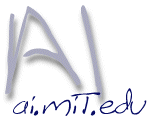 |
|
|
Roughly every fifty years humanity solves a great mystery of science.
We have a chance to solve such a mystery now:
- How does the human mind work?
There are many corollary questions to answer:
- Where does the mind reside?
- What is the nature of memory?
- What are the roles of emotions?
- What sort of representations does the brain use?
- What does our visual system compute?
- How did evolution shape us?
- How do we learn?
- What is consciousness?
Today we have the first opportunity in twenty years to attack all these
questions in decisive new ways. New tools, new resources and new
information are all available.
If we can think imaginatively enough and turn that imagination into
solid scientific theories and solid engineering demonstrations then
we can meet this grand challenge.
|
Why now?
|
|---|
|
A number of events are converging
that make this time one of great promise for our research:
- There has been a realization amongst many people at our Lab that the
keys to intelligence are self adapting perceptual systems, motor systems,
and language related modules. This is in marked contrast to earlier
approaches that focused on reasoning, planning, and knowledge representations
as the keys to Artificial Intelligence.
- A whole host of new techniques for imaging the brain while it
perceives, acts, and produces utterances are giving new insights into
how components of human intelligence interact. The answers all look
very different from earlier models derived from introspection and
protocol analysis. Multi-cell recording in animal nervous systems is
further illuminating how natural systems perceive, remember, and act.
- From 1970 to 1990 the peak amount of computer power available for
an individual AI researcher (anywhere) remained approximately constant
at around 1 mips, while the cost dropped a factor of 200, as we (generic
computer researchers)
migrated from one big computer for a whole lab to individual
workstations. Since 1990 we have picked up more than two
orders of magnitude processing for individual graduate students with
approximately constant cost. In addition,
much larger central computational systems are becoming available for dedicated
experiments, giving yet another order of magnitude increase. This
trend will continue as costs remain constant.
We are thus armed with a new direction, we have new data on how natural
systems work, and we have significant new levels of computation available.
Our challenge is to take these three components that have been thrust upon
us (to a greater or lesser degree by developments over the last thirty
years made within the Lab itself, mixed with many outside developments)
and synthesize new scientific results, create new engineering applications,
and to answer the big question.
It is a big challenge. It is worth going after with all our hearts
and minds. It is worth the daring that is required for success.
|
What happens along the way?
|
|---|
|
Since Marvin Minsky and John McCarthy formed the Lab in 1959
it has always been a place where significant new tools
and applications have been developed.
The great strength of the AI Lab has always been a willingness to put
together large scale systems in ways that others have either not
dared or for which they have not been able to marshal the required
resources. Since the very early days the Lab has also been a place
where robotics and computer vision have been great strengths. In
all areas we have had much success in the building of software
and computer hardware systems.
These traditions are all alive and well, and the last few years have
seen significant applications built on our robotics, vision, language,
and circuit design
technology. We have recently pioneered new methods for image
guided surgery, wired the Whitehouse, made haptic interfaces a reality,
produced new generations of micro displays, and changed the way NASA explores
planets. Twenty active companies have spun off from the Lab in
just the last few years.
This activity will not abate any time soon. There are dozens of new
applications currently being developed at the Lab helping surgeons,
assisting the disabled, replacing precision mechanical
components with computation, building new classes of human computer
interfaces, providing new capabilities in image indexing, and hijacking
biochemistry to do computation for us.
Our work in exploring intelligence feeds these applications. Our work
on applications gives us new tools to explore intelligence. It is
a symbiosis that has worked for us for a long time, and it appears
that it will continue to work for the forseeable future.
|
One big monolithic family?
|
|---|
|
Certainly not! There are many shades of opinion, many different approaches
to particular problems, and many heated debates. The answers are not
clear at all (unless you ask an individual...). There is lots of work
to be done to get to the big new answers, and a thousand flowers
must bloom if we are to be successful.
At the same time there is a new sense of general direction in the
MIT AI Lab, and it is
different from where AI has been headed during the last twenty years. We
are one big family, big enough to disagree on the details,
but big enough to have a common direction.
To find out more, visit our home
page, peruse our research
projects, look at our research abstracts or
our publications, or
browse the home
pages of our people.
|
|
|
|
 |
